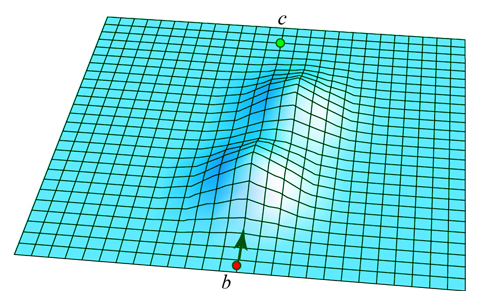I am interested in what might be called rolling geodesics, paths
of physical particles confined to a surface in $\mathbb{R}^3$
under certain force conditions.
Here I will pose a specific (but imprecise)
recreational question that addresses some aspects these curves:
Design a wickedly difficult golf green.

Let $D \subset \mathbb{R}^2$ be a unit-radius disk in the plane.
Let $h(x,y)$ be a continuous, smooth function defined over $D$;
$h(x,y)$ represents the height of a golf green surface $S$ over $(x,y) \in D$.
At a point $c \in S$ is centered a golf hole/cup of diameter $\delta$ larger than
the diameter of a golf ball, which is sitting at some spot $b \in S$ on the green.
The hole should project strictly interior to $D$, as should $b$.
The challenge is to design the shape of the green's surface
$S=h(x,y)$ to make it extremely difficult to hole a putt.
A putt imparts an instantaneous velocity $v_0$ to the ball at $b$, with the goal that the ball rolls under the influence of gravity and rolling friction with the grass so that its point of contact ends up suspended over the cup hole. Assume that, regardless of its velocity $v(t)$ at that moment, the ball is "sunk," i.e., it falls into the cup.
Some additional assumptions:
- The surface gradient is bounded, e.g., $|\nabla h| \le 1$. (Perhaps 1 is too generous. Rarely is a green sloped more than $10^\circ$.)
- Friction suffices to hold a carefully placed ball stationary-stable at any point $b \in S$.
- The initial velocity $v_0$ is bounded by the requirement that the ball never lifts-off the surface airborn at any point. (See the earlier MO question, Gently falling functions.) This rolling-constraint might be difficult to accommodate, in which case an upperbound $v_{\max}$ could be assumed.
- Assume that $D$'s fringe is surrounded by such a deep drop-off that a ball that leaves the domain of the green can never return.
Here are two specific questions:
Q1. Is there a surface $S$ with cup/pin placement $c \in S$ such that, for some starting point $b \in S$, it is impossible to 1-putt from $b$?
If the answer to Q1 is Yes, then:
Q2. Given any integer $k>1$, is there an $S$ and $c \in S$ that requires $\ge k$ putts to sink the ball from some $b \in S$ into the cup?
Insights under any assumptions (either more or less realistic) welcomed!
(Credit to Alejandro López-Ortiz, who posed several geometric golf questions [but not this specific one] at a conference in August 2011.)
Addendum. Here is Jaap Eldering's example:


